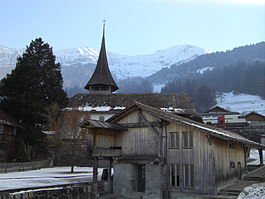Leissigen
| Leissigen | ||
|---|---|---|

Leissigen village church and mill
|
||
|
||
| Coordinates: 46°39′N 7°46′E / 46.650°N 7.767°ECoordinates: 46°39′N 7°46′E / 46.650°N 7.767°E | ||
| Country | Switzerland | |
| Canton | Bern | |
| District | Interlaken-Oberhasli | |
| Government | ||
| • Mayor | Daniel Steffen | |
| Area | ||
| • Total | 10.36 km2 (4.00 sq mi) | |
| Elevation | 575 m (1,886 ft) | |
| Population (Dec 2015) | ||
| • Total | 1,020 | |
| • Density | 98/km2 (250/sq mi) | |
| Postal code | 3706 | |
| SFOS number | 0585 | |
| Surrounded by | Därligen, Saxeten, Aeschi bei Spiez and Krattigen. | |
| Website |
www SFSO statistics |
|
Leissigen is a municipality in the Interlaken-Oberhasli administrative district in the canton of Bern in Switzerland.
The name Leissigen comes from the Old High German personal name Lantgis and the toponymic suffix -ingun, meaning "of the people of Langtis."
Leissigen is first mentioned in 1285 as Lensengne. In 1290 it was mentioned as Lenxingen.
The oldest traces of a settlement in the area are scattered Bronze Age axes, daggers and swords. The first time the village appears in the historic record, during the Middle Ages, it belonged to the Herrschaft of Unspunnen-Rotenfluh. It was eventually inherited by the Freiherr of Weissenburg, who gave it to Interlaken Abbey in 1334. The village remained under the Abbey's control for almost two centuries. In 1528, the city of Bern adopted the new faith of the Protestant Reformation and began imposing it on the Bernese Oberland. Lauterbrunnen joined many other villages and the Abbey in an unsuccessful rebellion against the new faith. After Bern imposed its will on the Oberland, they secularized the Abbey and annexed all the Abbey lands.
The oldest village church was probably a wooden church from the 7th or 8th century. The probable wooden one was replaced with a stone building in the 9th or 10th century. The first stone church was replaced with an Early Medieval building in the 11th century. This second stone church was mentioned in the Strättliger Chronicle as one of the twelve churches around Lake Thun. The current building was built following a devastating fire in 1675.
...
Wikipedia




